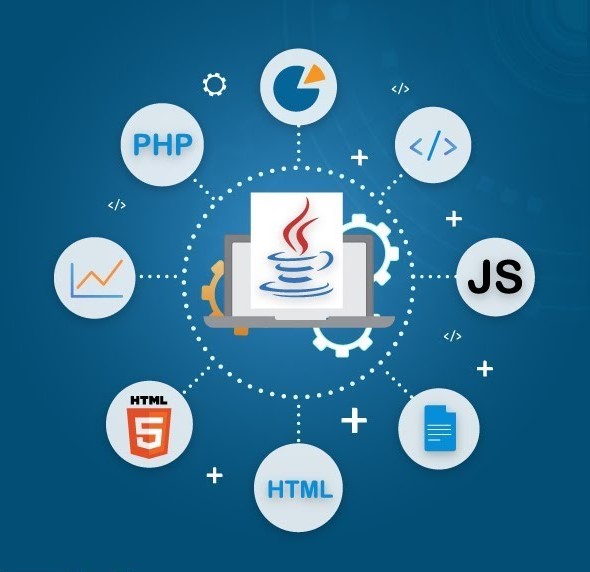

Java Course Details
Chapter 1- Introduction
Types of Programming language
and Paradiagrams
Java – what, where and why?
Comparison in Java with C and
C++
Features of Java Language
The Java Virtual Machine (JVM)
Role of Java Programmer in
Industry
JDK , JRE and JIT
Chapter 2: Language Fundamentals or Grammar of Java
Installing Java in WINDOWS and LINUX
Java Program Development in different environment
Java Source File Structure
Introduction to VI, notepad, edit plus editor and Net beans, Eclipse
IDE
Compilation and Executions procedure using different editor
and IDE
Reference parameters, Output parameters
Access specifiers and its
requirement in java
Chapter 3: Primitive Data types and Block in java
Data types
int, char, float, double, Boolean, short, long, byte
UNICODE system
Value type, Reference type
Types and Scope of variables
Static variables, Instance variable, Local variables, final
variable, transient variable, volatile variable
Static block and Non-static block
Static,non-static,final,abstract,native and synchronized
Communicate java application with other language using java
native interface
Arrays & Strings
Chapter 4: Java Operators
Arithmetic operators
Relational operators
Logical operators
Shift operators
Assignment Operators
Unary operator
Bitwise operators
Special operators
Ternary operator
Chapter 5: Wrapper Class
Integer
Character
Float
Double
Boolean
Short
Long
Types of Conversions
Implicit conversion, Explicit conversion
Chapter 6:Statement & Looping
If statement
If….Else statement and if….else ladder
Nested if
Multiple if
Switch... case statement
Conditional operator vs. if statement
Break and continue in java
While,Do,For,For each
Chapter 7:Object Oriented
Programming
Class Fundamentals
Object & Object reference
Life time of object & Garbage Collection
Creating with Operating reference and Objects
Constructor & initialization code block
Access Control, Modifiers, methods
Nested, Inner Class & Anonymous Classes
Abstract Class & Interfaces
Defining Methods, Argument Passing Mechanism
Method Overloading, Recursion
Design of Accessors and Mutator Methods
Generic Class Types
Chapter 8: Java Advanced
Data Structures
Collections
Generics
Serialization
Networking
Sending Email
Multithreading
Applet Basics
Chapter 9: A Simple Servlet
Example Two-tiered Web Application
J2EE Software and Setup
Environment, Path and Classpath Settings
J2EE Application Components
Create the HTML Page
Create the Servlet
Compile the Servlet
Start the J2EE Application Server
Start the Deployment Tool
Assemble the J2EE Application
Verify and Deploy the J2EE Application
Run the J2EE Application
Updating Component Code
Chapter 10: A Simple Session Bean
Example Application Overview
Create the Session Bean
Local Interfaces
Modify the Servlet
Compile the Session Bean and the Servlet
Start the Platform and the Tools
Assemble the J2EE Application
Verify and Deploy the J2EE Application
Run the J2EE Application
Chapter 11: A Simple Entity Bean
JMS Overview
Create the Message-Driven Bean
Change the Servlet
Start the Platform and the Tools
Assemble the J2EE Application
Verify and Deploy the J2EE Application
Run the J2EE Application
Chapter 12: Cooperating Enterprise Beans
Change the Entity Bean
Change the Session Bean
Change the Servlet
Start the Platform and Tools
Assemble the Application
Verify and Deploy the J2EE Application
Run the J2EE Application
Chapter 13: JavaServer Pages Technology
Change the Entity Bean
Change the Session Bean
Change the Servlet
Start the Platform and Tools
Assemble the Application
Verify and Deploy the J2EE Application
Run the J2EE Application
Chapter 14:Adding JavaBeans to the Mix
About the Example
Create bonus.jsp
Create the JavaBeans Class
Bean Properties
Change the Servlet
Start the Platform and Tools
Update the WAR File
Verify and Deploy the J2EE Application
Run the J2EE Application
Chapter 15: Custom JSP Tag Libraries
About the Example
Custom JSP Tag
Declare the Tag Library
Create the Tag Library Descriptor
Create the Tag Handler Class
Change bonus.jsp
Start the Platform and Tools
Update the WAR File
Verify and Deploy the J2EE Application
Run the J2EE Application
More Information Gladiator-Predator Testing
Chapter 16: XML
Marking and Handling Text
Change the JavaBean Class
Creating the XML document using DOM
Parsing XML using SAX
SAX and DOM
XML and J2EE
Change the Servlet
Compile the Application
Update the Application
Verify and Deploy the J2EE Application
Chapter 17:JDBC Technology and Bean-Managed Persistence
Bean Lifecycle
Change the BonusBean
Other Components
Create the Database Table
Start the Platform and Tools
Update the JAR File
Verify and Deploy the Application
Run the Application
Click to Register

